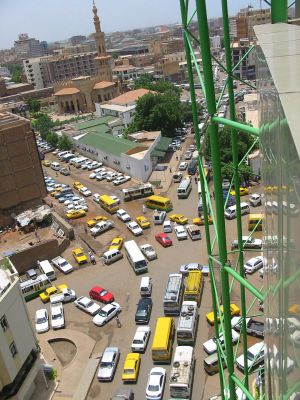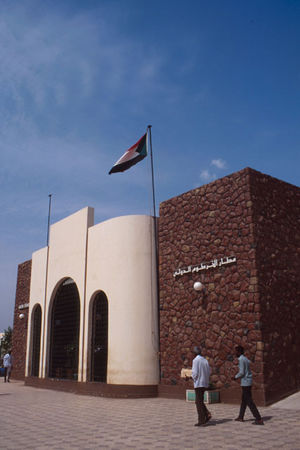Khartoum
2007 Schools Wikipedia Selection. Related subjects: African Geography
Khartoum (الخرطوم al-Ḫarṭūm "Elephant Trunk") is the capital of Sudan and of Khartoum State. It is located at the point where the White Nile, flowing north from Uganda, meets the Blue Nile, flowing west from Ethiopia. The merger of the two niles is known as "the Mogran". The merged Nile flows north towards Egypt and the Mediterranean Sea.
The city proper has a population of well over a million inhabitants, making it the second largest city in the country, but forms with its neighbours, linked by bridges, Khartoum North (al-Khartūm Bahrī) and Omdurman (Umm Durmān) a metropolis with a population totaling over four million.
History
Early history
Khartoum was founded in 1821 by Muhammad Ali , the ruler of Egypt, as an outpost for the Egyptian army, but grew as a regional centre of trade, including the slave trade. Troops loyal to the Mahdi Muhammad Ahmad laid siege to Khartoum starting on March 13, 1884 against the defenders led by British General Charles George Gordon, resulting in the massacre of the Anglo-Egyptian garrison.
The heavily damaged city fell to the Mahdists on January 26, 1885. Omdurman was the scene of the bloody battle ( September 2, 1898) in which British forces under Sirdar Horatio Kitchener defeated the Mahdist forces defending the city.
In 1899 Khartoum became capital of Anglo-Egyptian Sudan and, with the independence of Sudan in 1956, the capital of the new country.
Recent history
In 1973, the city was the site of a hostage crisis in which members of Black September held ten hostages at the Saudi embassy, five of whom were diplomats. The US ambassador, the US deputy ambassador, and the Belgian Chargé d'affaires were murdered. The remaining hostages were released (see Khartoum diplomatic assassinations).
The first oil pipeline between Khartoum and Port Sudan was completed in 1977.
Throughout the 1970s and 1980s, Khartoum was the destination for hundreds of thousands of refugees fleeing conflicts in neighboring nations such as Chad, Eritrea, Ethiopia and Uganda. The refugees settled in large slums at the outskirts of the city. From the mid-1980s onward, large numbers of internally displaced from the violence of the Second Sudanese Civil War and Darfur conflict have settled around Khartoum.
Following the 1998 U.S. embassy bombings, the United States accused Osama bin Laden's al-Qaeda group of responsibility and launched cruise missile attacks ( August 20) on the al-Shifa pharmaceutical factory in Khartoum. The factory, whose destruction had devastating effects on the Sudanese economy, may have been wrongly targeted as strong evidence against any ties to bin Laden has surfaced.
The Arab League summit of March 28-29, 2006 was held in Khartoum, during which the Arab League awarded Sudan the Arab League presidency.
Development
After the signing of the historic Comprehensive Peace Agreement between the government of Sudan and the Sudanese Peoples Liberation Movement (SPLA), the Government of Sudan has begun a massive development project. The biggest project taking place right now in Khartoum is "Al-Mogran" Development Project, led by Al-Sunut Development Company. This integrated development is a joint venture developed by the DAL Group Company Ltd, Khartoum State and the National Social Insurance Fund. The project is divided into two main phases:
Phase I : Almogran Central Business District A brand new 160-acre Central Business District (CBD). This state-of-the-art, prime commercial real estate will act as a hub for Eastern Africa’s modern business market. Almogran is located on the junction between The White and the Blue Nile. The CBD has been carefully master planned to create a dynamic and livable business environment, with pedestrian-friendly tree-lined streets, a river walk, and a mix of business, commercial, and residential properties.
Phase II : Almogran Residential Estate To the south of Almogran CBD, along the banks of the White Nile, lies a 1500-acre residential development featuring a variety of carefully planned neighborhoods of luxurious villas, townhouses, and apartments, complete with supporting neighbourhood shops, schools, and recreational and leisure facilities. The development includes an 18-hole signature golf course and resort, public parks and gardens, with preservation of the Sunuut Forest Reserve.
Economy
Among the city's industries are printing, glass manufacturing, food processing and textiles. However, the economy is still progressing. Petroleum products are now produced in the far north of Khartoum state, providing fuel and jobs for the city. One of Sudan's largest refineries is located in northern Khartoum.
Education
Khartoum is the main location for most of Sudan's top universities, including but not limited to:
- University of Khartoum. Originally founded as Gordon Memorial College in 1902, it was later renamed to share the name of the city in the 1930s.
- The Academy of Medical Sciences and Technology.Better known as AMST,it was founded in 1996 by Prof. Mamoun Humaida in the heart of Khartoum City the capital of Sudan.Its considered to be one of the best eduacational establishments in the country and viewed by most to be the pioneer Private University in Sudan
- University of Sudan for Science and Technology
- Computer Man College
- Juba University. It was relocated from Juba during the civil war. Currently plans exist to relocate the university back to its original location.
- Bayan Science and Technology University
Transportation
Air
Khartoum is home to the largest airport in Sudan, Khartoum International Airport. It is the main hub for Sudan Airways, Sudan's main carrier. It was built in the southern edge of the city, but the rapid growth of the city and through the major urbanization, it has become the heart of the city. A new international airport is currently being built in the city of Omdurman. It will replace the current airport in Khartoum as Sudan's main airport followed by Juba Airport and Port Sudan Airport.



